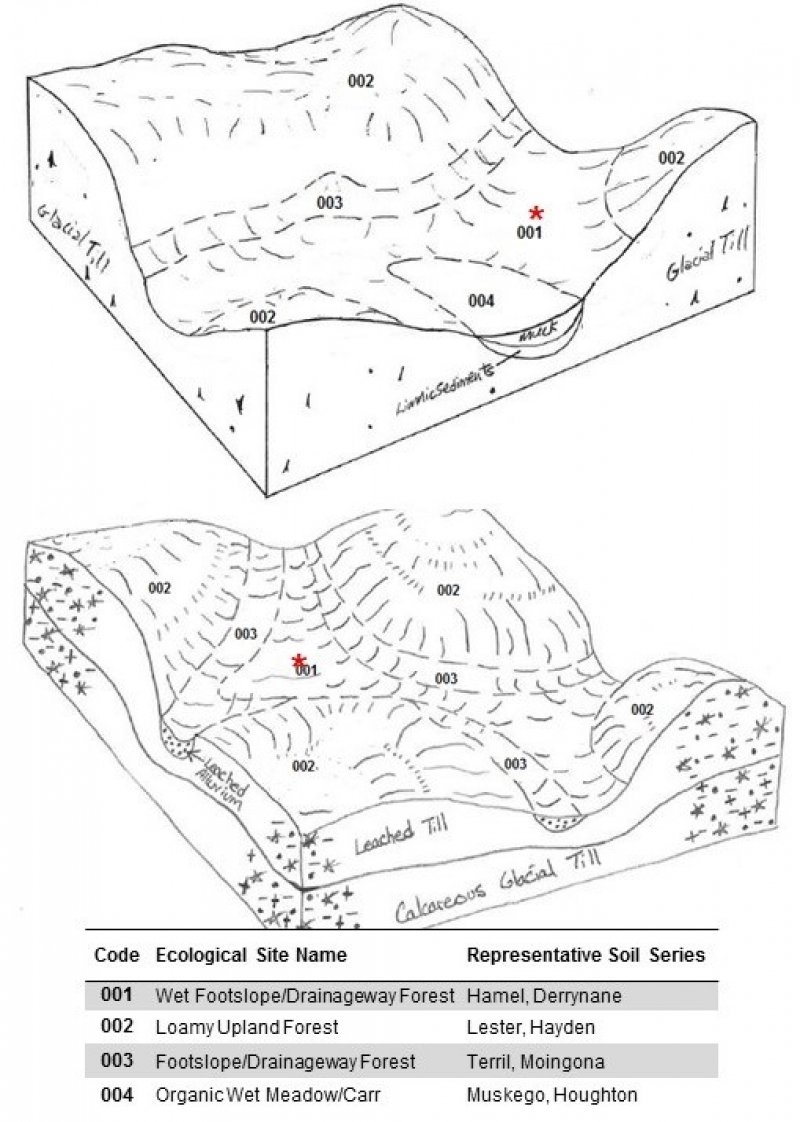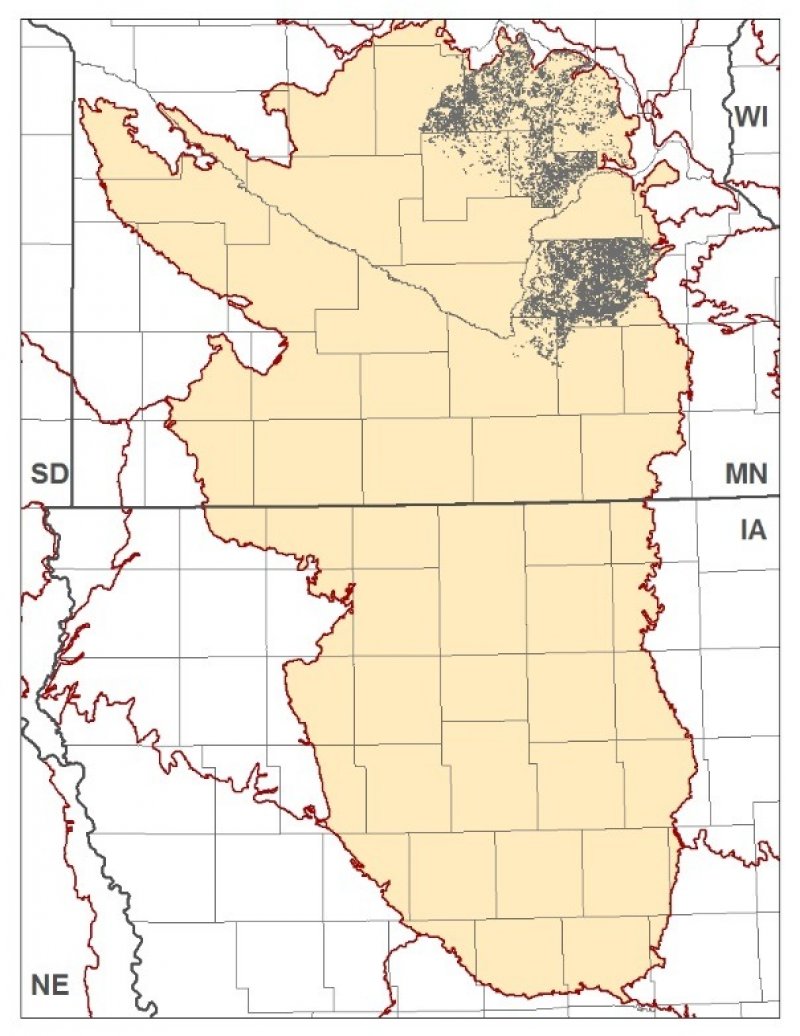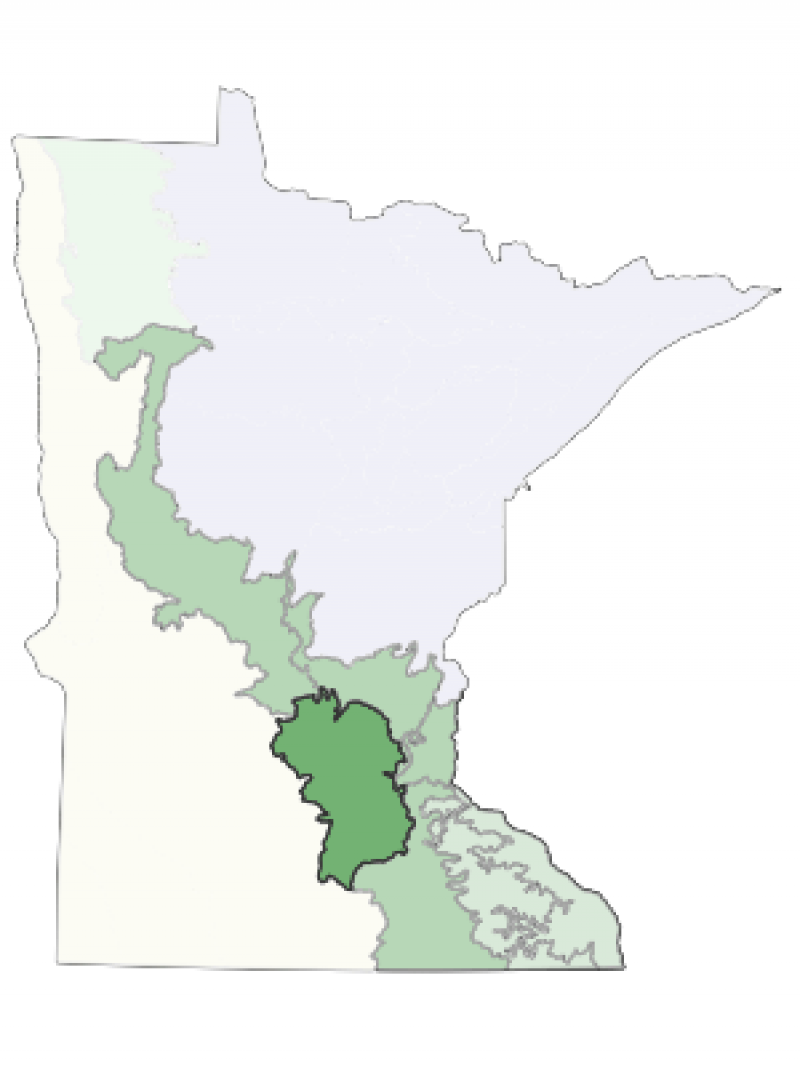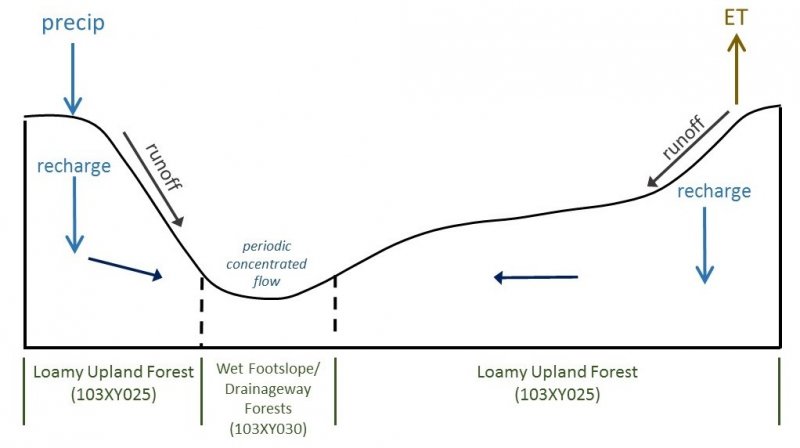Ecological dynamics
The reference state is a mature deciduous forest with multiple co-dominant tree species. The site is found predominantly in the northeastern part of MLRA 103 where fires were historically suppressed by topography and density of waterbodies. This ecological site is generally stable in absence of large-scale natural or anthropogenic disturbances.
Three states are included in the state and transition model at this time. The Reference State, the Tillage State, and the Disturbed Forest State.
Following European settlement, most areas were cleared of their trees and converted to agriculture. Currently, the dominant land use is corn and soybean production. Remaining unfarmed areas include forested preserves and other miscellaneous land uses.
State 1
Reference State
The Wet Footslope/Drainageway Forests reference state is a mature, hardwood forest with multiple canopy species including American elm, sugar maple, slippery elm, and ash. The understory on high-quality sites is diverse and boasts a variety of native herbaceous and grass species. In absence of large-scale natural or anthropogenic disturbances, this ecological site is generally stable. Small gap regeneration occurs commonly. Common species in early and mid-successional stage communities include maple, elm, and ash.
Resilience management. Resilience management practices include monitoring for invasive vegetation, applying herbicides as needed, and excluding grazing and logging.
Community 1.1
Reference Community
Canopy dominants include American elm, sugar maple, slippery elm, and ash. Common shrub species include chokeberry. High-quality reference sites are now rare in MLRA 103 and many of the existing wooded sites have been disturbed by human activities (State 3) or transitioned to agricultural production (State 2).
Resilience management. Resilience management practices include monitoring for invasive vegetation, applying control methods as needed, and excluding disturbances such as grazing.
State 2
Tillage State
The Tillage State contains the Row Crop Community and the Seeded Grassland Community. This state describes areas currently in crop production or areas that were tilled but now are seeded to grass. Pathway mechanisms include preparing the site, planting desired species, applying herbicide, applying fertilizer, and harvesting. Hydrological modifications (tiling and ditching) are commonly installed to improve drainage.
Soil tillage alters dynamic soil properties, including bulk density, structure, organic carbon content, and saturated hydraulic conductivity. Intensive tillage negatively impacts soil ecological functions. Conservation practices help mediate soil health impacts. Conservation tillage minimizes soil disturbance and improves soil structure and soil health. A cover crop rotation builds soil structure, improves infiltration rates, reduces runoff and erosion, and protects water quality.
Some areas have been converted to a warm-season grasses under a NRCS conservation program. Plantings may include native grasses and forbs that benefit wildlife and pollinators. Non-native, cool-season grasses are also feasible for this site. Common species include reed canarygrass (Phalaris arunidinacea L.), and Kentucky bluegrass (Poa pratensis L.). Seed mix selection will depend on site characteristics and landowner objectives. Seeded grasslands are not as species rich or biologically diverse as native grasslands; however, they still offer ecological benefits to wildlife, water quality, and soil health.
Resilience management. Prescribed fire is a resilience management practice on warm-season grasslands.
Seeding, fertilizing, and controlling weeds and brush are resilience management practices for cool-season grasslands.
Community 2.1
Row Crop Community
Community 2.1 consists of intensive row crop agriculture. This is a primary use of this ecological site. Soil tillage and intentional plant establishment are the primary triggers. The most common crops are corn and soybeans on an annual rotation. Many crops, however, are feasible for these areas. A secondary trigger is drainage modifications (ditching and tiling), which are often installed to improve soil drainage.
Conservation tillage practices may be implemented to reduce soil erosion while still maintaining a crop rotation. These practices protect the soil surface from erosion and allow water to infiltrate instead of running off. Examples include no-till or ridge-till, which leave residue on the surface of the field.
Additional soil health benefits can be gained by adding alternative crops to fields that are already in conservation tillage. By diversifying the crop rotation, landowners take additional management steps to improve soil health and protect water quality. Species may include legumes, clovers, beans, turnips, or small grains such as ryegrass, oats, rapeseed, winter wheat, winter rye, and buckwheat.
Resilience management. Resilience management practices include preparing the sites, planting, fertilizing, controlling weeds, and harvesting. The maintenance of the desired vegetation community is controlled by the intensity, frequency, duration, and timing of agricultural practices.
Community 2.2
Seeded Grassland Community
The Seeded Grassland Community grows in areas that were previously tilled and used for agricultural production, but have been transitioned to either warm-season or cool-season grasses. The primary trigger is the intentional establishment of a grass species. Warm-season grasses are commonly planted through a NRCS conservation program. Seed mix selection depends on site specifics and landowner objectives.
Many cool-season grasses can be planted, depending on landowner goals. Management inputs include seeding, fertilizing, and controlling weeds and brush.
Resilience management. The resilience management practices may include planting desired species, managing grazing, mowing, fertilizing, and controlling unpalatable plant species.
Prescribed fire is a resilience management practice for warm-season grasslands. The controlled application of fire modifies vegetation structure and influence ecological processes.
Pathway 2.1A
Community 2.1 to 2.2
This pathway converts Community 2.1 (row crops) to Community 2.2 (seeded grassland). The primary mechanism of change is the seeding of desired grass species. Commercial vegetative seed mixes commonly include a variety of native grasses and forbs to enhance wildlife habitat and to benefit native pollinators. This pathway is commonly triggered in conjunction with a conservation program such as the NRCS Conservation Reserve Program (CRP). The site is removed from crop production and seeded with warm-season grasses which benefit wildlife, soil health, and water quality.
Multiple resilience management practices may be utilized after warm-season grass establishment. Examples include prescribed fire, brush management, and herbaceous weed treatment. Prescribed burning is often utilized to reduce the extent of woody vegetation, reduce the buildup of dead plant material, and promote the regeneration of grasses and forbs.
Cool-season grasses may be planted. Species include Kentucky bluegrass, reed canarygrass, tall fescue, perennial rye, and timothy. Legumes, such as white clover and red clover, are commonly incorporated to improve forage nutrition. A small percentage of MLRA 103 currently supports cool-season grasses. Resilience management practices for cool-season grass sites include planned grazing, invasive plant management, and harvest management (hay production).
| Forage and Biomass Planting |
|
Pathway 2.2A
Community 2.2 to 2.1
This pathway describes the site transitioning from a seeded grassland to row crop agriculture. This is a common pathway throughout MLRA 103 as sites are placed in crop production.
The mechanisms of change are tillage and intentional plant establishment (crop seeding). Resilience management practices include weed control (herbicide application), disturbance management (field cultivating), and harvest management.
State 3
Disturbed Forest State
This state describes a wooded site that has been disturbed and exhibits altered forest species composition. Numerous ruderal communities may occur on this ecological site depending on the type and severity of disturbance, the length of disturbance, available seed sources, ongoing disturbances (selective harvest, grazing), and management activities. Fast-growing, shade tolerant trees are typical. Tree species often include maple, box elder, hackberry, ash, and elms. Invasive non-native species are often present and can become dominant without management intervention.
Community 3.1
Disturbed Forest Community
Community 3.1 is an altered forest community caused by previous or ongoing human disturbances. Invasive species are common in this community. Canopy composition varies depending on the severity and type of disturbances, community age, and the availability of seed sources. Various invasive, non-native species are common and will continue to increase without management intervention.
Transition T1A
State 1 to 2
Transition T1A is the conversion of the Reference State to agriculture. The triggers are site clearing, hydrological modifications (ditching/tiling), soil tillage. and intentional plant establishment (crop seeding). Resilience management practices include common agricultural practices such as seeding, fertilizing, and managing invasive plants with herbicides or field cultivation.
Constraints to recovery. Site clearing and soil tillage preclude recovery of the former state.
Transition T1B
State 1 to 3
Transition T1B is a transition from a mature deciduous forest to a disturbed (ruderal) forest. Triggers include altered hydrology, timber harvest, surface site disturbance, grazing, and introduction of non-native species. The native plant community is altered, and these areas do not exhibit the ecological function or vegetative composition of State 1.
Restoration pathway R3A
State 3 to 1
Restoration to the Reference State may be feasible for some sites with long-term management inputs including restoration of natural hydrology, establishment of desired species, forest stand management (selective thinning), and control of invasive species.
Triggers include intentional plant establishment (planting desired species), absence of disturbance (site protected from grazing and other site altering disturbances), timber stand improvement inputs, and eradication of invasive plant species.
| Brush Management |
|
| Tree/Shrub Site Preparation |
|
| Tree/Shrub Establishment |
|
| Forest Stand Improvement |
|
Transition T3A
State 3 to 2
Transition T3A is the transition of a disturbed forest state to agriculture production. This is a common pathway in MLRA 103.
The mechanisms of change include site clearing, hydrological modifications (ditching/tiling), site preparation, tillage, and intentional plant establishment (crop seeding). Continued resilience management practices are necessary and include weed control (herbicide application), disturbance management (field cultivating), and harvest management.
Constraints to recovery. Soils tillage and the transition to agriculture preclude recovery of the former state.




